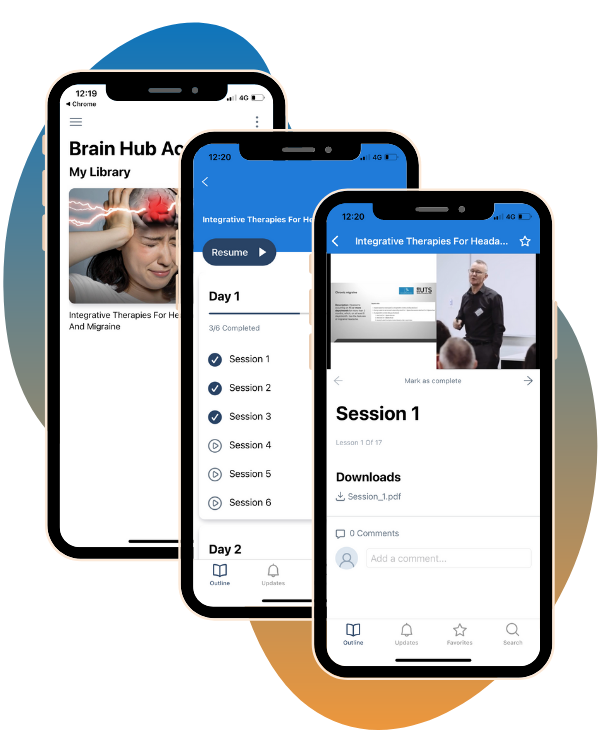EDUCATION FOR HEALTHCARE PRACTITIONERS IN VESTIBULAR NEURO-REHABILITATION™
Brain Hub Academia aims to educate healthcare practitioners in the area of vestibular neuro-rehabilitation™, by translating the latest evidence-based research and guidelines into clinical applications that are suited for all levels
LEARN MOREDiscover The Underlying Causes
Of Neurodevelopmental Conditions Such As
Autism, ADHD, Asperger's, Dyslexia And More
With Dr Robert Melillo
In Clinic And At Home
Brain Hub Academia is proud to host Dr Melillo's Exclusive Home-Study and On-Demand Courses! Recorded live in Australia, they are custom tailored for patients, parents, and practitioners
#1 - Neurodevelopmental Foundations
A foundational course that outlines the Melillo Method, the research and how to help children and adults with neurodevelopment conditions
#2 - NeuroParenting Mastery
A unique Q+A opportunity for patient/caregiver/parents with Dr Melillo. Your chance to listen to and ask Dr Melillo questions that relate to specific conditions, therapy, home care, his books, research and more
#3 - Advanced Clinical Applications
Advanced clinical application for practitioners to enhance their knowledge and patient outcomes, with cases, protocols and management
Learn More
Dr Robert Melillo Facebook Groups
If you're a healthcare practitioner, then be sure to join the closed Facebook group for the latest information https://www.facebook.com/groups/707313693706349
If you're a parent, caregiver or patient, then be sure to join the closed Facebook group for the latest information https://www.facebook.com/groups/630378225504983

RECORDED COURSE
Functional Neuro-Development: The Melillo Method
Filmed in Sydney (March 2022) - 45 hour condensed program
The Melillo Method is a complete methodology and tool-kit that aims to help both paediatric and adults patients with a range of neuro-developmental imbalance. History forms, diagnostic checklists, clinical rationale and treatment approaches have been developed for the practitioner in mind.
This is a professionally filmed and edited recording of the live Sydney event in March 2022. The hours count towards the Fellowship off Childhood NeuroDevelopment and hours for CAGEN (Chiropractic Neurology diplomate) and IAFNR.
Additional special offers are available combining this course with Dr Melillo's online courses
MOST POPULAR ONLINE COURSES

$895
Online: Vestibular Neuro-Rehabilitation Applications for the Spine – Scoliosis and Posture
WELCOME TO BRAIN HUB ACADEMIA
Brain Hub Academia aims to educate healthcare practitioners in the area of vestibular rehabilitation, by translating the latest evidence-based research and guidelines into clinical applications that are suited for all levels. The goal is to improve the clinical competency of practitioners and the outcomes of their patients suffering from dizziness, vertigo, whiplash, concussion, poor balance and chronic spinal conditions.
Brain Hub Academia provides its training via online and classroom environments, as well as offer introductory and competency-based certification programs to excel your knowledge. We’re confident there is a level of learning suited to your needs, as well the option of a hands-on or online experience to meet your demands.
WHY CHOOSE BRAIN HUB ACADEMIA

INTERACTIVE ONLINE COURSES

LIVE COURSES WITH THE INDUSTRY'S BEST

LISTED ON OUR PRACTITIONER NETWORK

INSTANT CERTIFICATION FOR PRACTICING

10+ COURSES TO UPSKILL

ACCESS TO FREE RESOURCES
LEARN ANYTIME, ANYWHERE
With access to over 10+ free and paid courses becoming a BHA member will help you gain the required skills to help more people gain a better quality of life.
Run by practitioners, Brain Hub Academia understands the challenges of running a practice and re-educating at the same time. That’s why we’ve invested into building the best online learning platform available for you to complete online anywhere.
Take a free course to see how user friendly the system is and become the expert in your location.


BECOME THE EXPERT IN YOUR LOCATION
Rub shoulders with the best in the industry and be recognised as the leading expert in your local area for completing our online courses or participating in our live courses with international leaders in the field.
All finished course participants are presented with a certificate of recognition and featured on our global Practitioner Locator.
FIND YOUR COURSE


